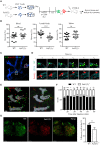Pak1 Kinase Promotes Activated T Cell Trafficking by Regulating the Expression of L-Selectin and CCR7
- PMID: 30891040
- PMCID: PMC6411651
- DOI: 10.3389/fimmu.2019.00370
Pak1 Kinase Promotes Activated T Cell Trafficking by Regulating the Expression of L-Selectin and CCR7
Abstract
Normal function of the adaptive immune system requires trafficking of T cells between the blood and lymphoid organs. Lymphocyte homing to lymph nodes requires that they cross endothelial barriers present in blood vessels and lymphatics. This multi-step process requires a remodeling of the lymphocyte plasma membrane, which is mediated by the dynamic re-arrangement of the actin cytoskeleton. Pak1 plays a central role in cell morphology, adhesion and migration in various cell types. Here we demonstrate that Pak1 is required for activated CD4+ T cell trafficking to lymph nodes. Pak1 deficiency in T cells causes a defect in the transcription of CCR7 and L-selectin, thereby altering lymphocyte trafficking. Additionally, we report an increase in L-selectin shedding in Pak1-deficient T cells, which correlates with a decrease in the recruitment of calmodulin to the cytoplasmic tail of L-selectin during T cell activation. Overall, our findings demonstrate that by regulating the expression of two major lymph node homing molecules, L-selectin and CCR7, Pak1 mediates activated CD4+ T cell trafficking.
Keywords: CCR7; L-selectin; L-selectin shedding; Pak1 kinase; lymph node trafficking.
Figures




Similar articles
-
Signaling through L-selectin mediates enhanced chemotaxis of lymphocyte subsets to secondary lymphoid tissue chemokine.J Immunol. 2012 Apr 1;188(7):3223-36. doi: 10.4049/jimmunol.1101032. Epub 2012 Mar 2. J Immunol. 2012. PMID: 22387549
-
Phosphatidylinositol-3-OH kinase and nutrient-sensing mTOR pathways control T lymphocyte trafficking.Nat Immunol. 2008 May;9(5):513-21. doi: 10.1038/ni.1603. Epub 2008 Apr 6. Nat Immunol. 2008. PMID: 18391955 Free PMC article.
-
Inducible costimulator controls migration of T cells to the lungs via down-regulation of CCR7 and CD62L.Am J Respir Cell Mol Biol. 2011 Oct;45(4):843-50. doi: 10.1165/rcmb.2010-0466OC. Epub 2011 Mar 18. Am J Respir Cell Mol Biol. 2011. PMID: 21421907 Free PMC article.
-
Multifaceted activities of CCR7 regulate T-cell homeostasis in health and disease.Eur J Immunol. 2012 Aug;42(8):1949-55. doi: 10.1002/eji.201242614. Eur J Immunol. 2012. PMID: 22700449 Review.
-
Phosphoinositide 3-kinase and the mammalian target of rapamycin pathways control T cell migration.Ann N Y Acad Sci. 2010 Jan;1183:149-57. doi: 10.1111/j.1749-6632.2009.05134.x. Ann N Y Acad Sci. 2010. PMID: 20146713 Free PMC article. Review.
Cited by
-
Changes in Adhesion and the Expression of Adhesion Molecules in PBMCs after Aneurysmal Subarachnoid Hemorrhage: Relation to Cerebral Vasospasm.Transl Stroke Res. 2024 Apr;15(2):378-387. doi: 10.1007/s12975-023-01136-6. Epub 2023 Feb 23. Transl Stroke Res. 2024. PMID: 36814009 Free PMC article.
-
CCR7 Has Potential to Be a Prognosis Marker for Cervical Squamous Cell Carcinoma and an Index for Tumor Microenvironment Change.Front Mol Biosci. 2021 Apr 1;8:583028. doi: 10.3389/fmolb.2021.583028. eCollection 2021. Front Mol Biosci. 2021. PMID: 33869272 Free PMC article.
-
An unexpected tumor-resistant phenotype from floxing PAK1 in a mouse model of colitis associated cancer.Sci Rep. 2025 Aug 9;15(1):29174. doi: 10.1038/s41598-025-12082-8. Sci Rep. 2025. PMID: 40783411 Free PMC article.
References
-
- Sallusto F, Lenig D, Förster R, Lipp M, Lanzavecchia A. Two subsets of memory T lymphocytes with distinct homing potentials and effector functions. Nature. (1999) 401:708–12. - PubMed
Publication types
MeSH terms
Substances
LinkOut - more resources
Full Text Sources
Molecular Biology Databases
Research Materials

